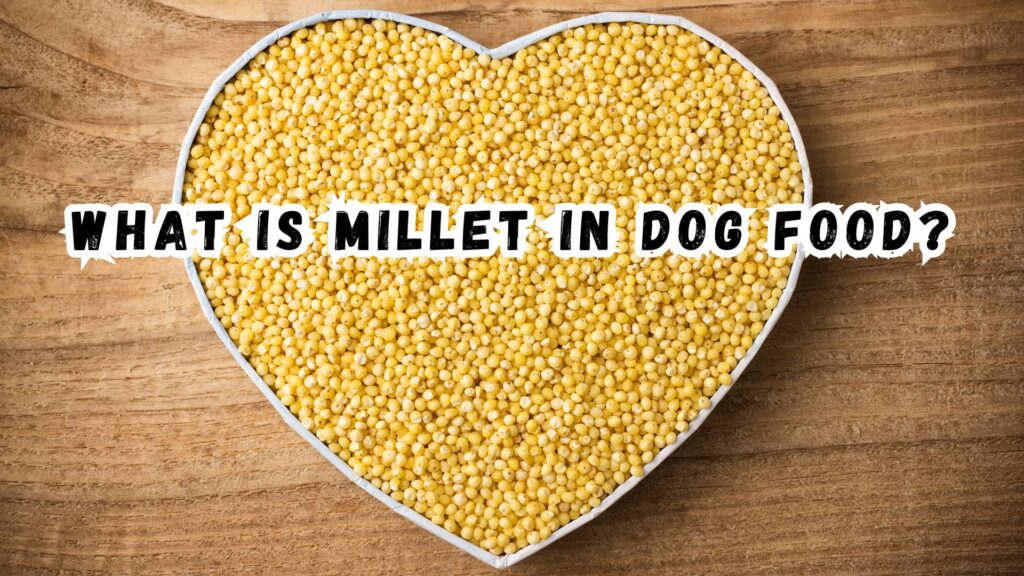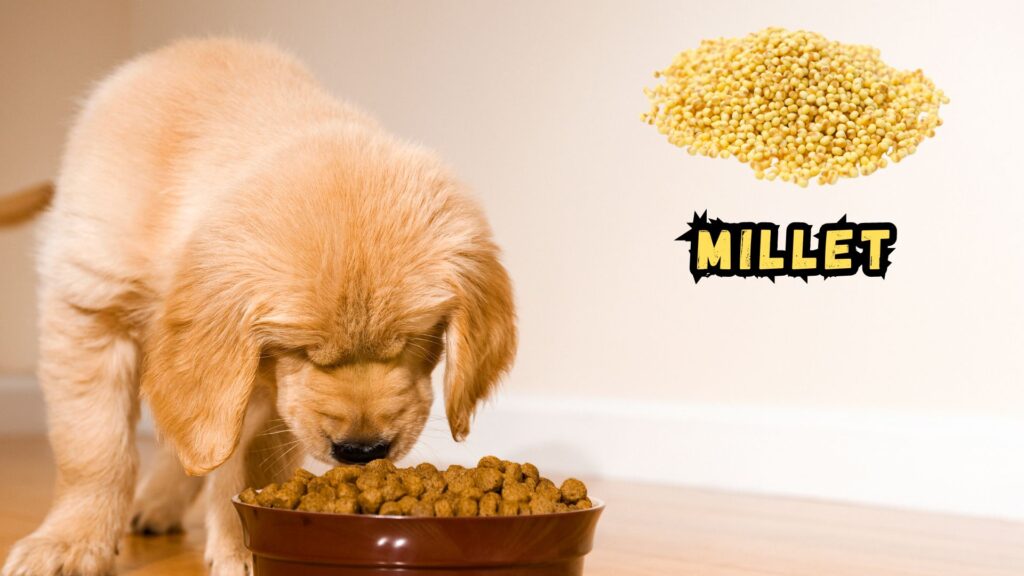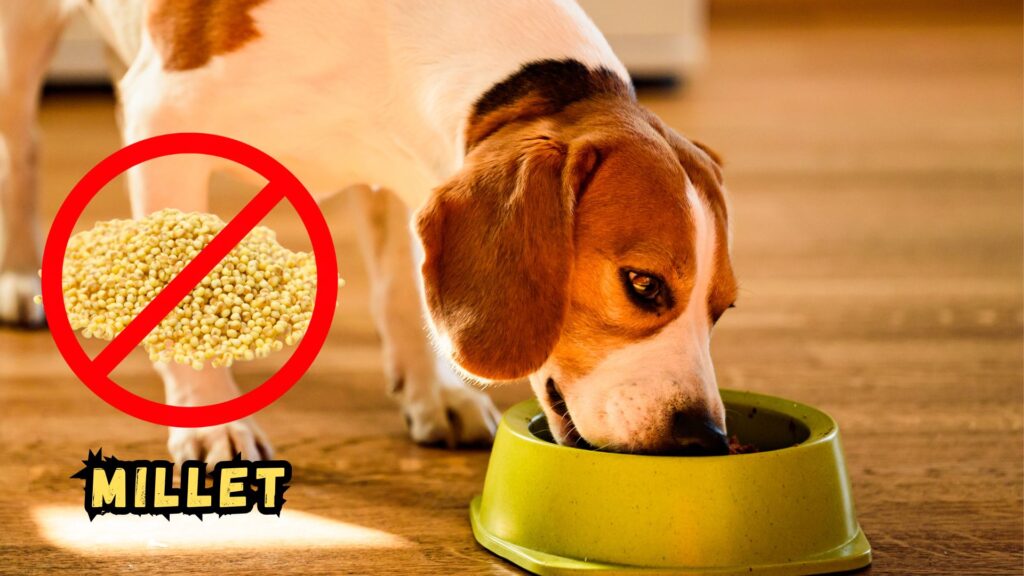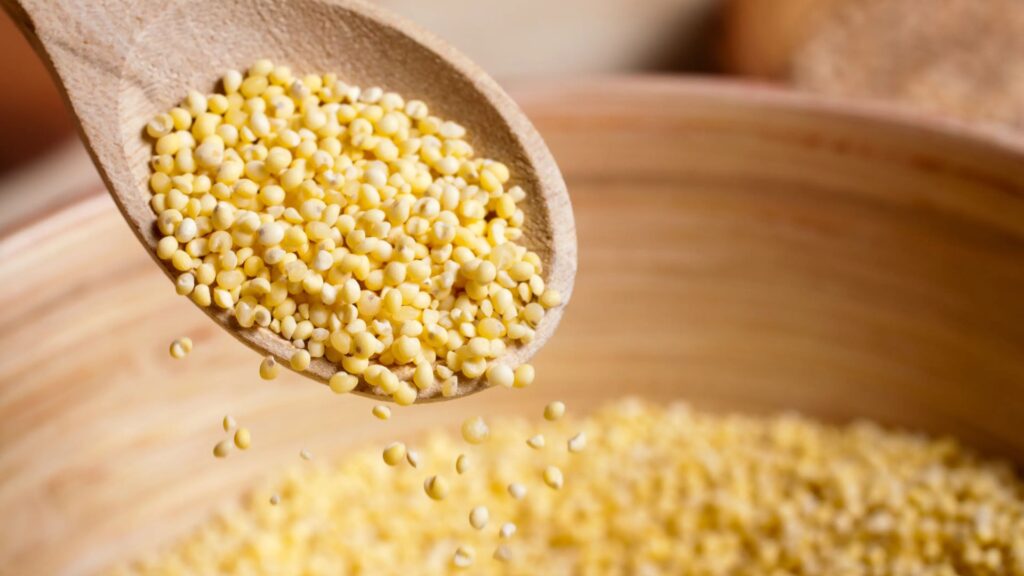Millet, a small-seeded grass, is increasingly becoming a popular ingredient in dog food. As a staple in many human diets for centuries, millet offers various nutritional benefits that can also support canine health.
Understanding the ingredients in your dog’s food is crucial for ensuring they receive a balanced and healthy diet.
This guide aims to provide a thorough understanding of millet’s role in dog food, outlining its benefits and potential risks, to help pet owners make informed decisions.

Understanding Millet
What is Millet?
Millet encompasses several varieties of small-seeded grasses, commonly used in birdseed but gaining traction in human and animal diets. There are several types of millet, including pearl, foxtail, proso, and finger millet. Each variety has its unique nutritional profile and benefits.
Nutritional Profile of Millet
Millet is a rich source of fiber, essential vitamins, and minerals. It provides significant amounts of B-vitamins (like niacin, B6, and folic acid), iron, magnesium, phosphorus, and potassium. Its high fiber content aids in digestion and can help manage weight by promoting a feeling of fullness.
History of Millet in Pet Food
Historically, millet has been a part of human diets in various cultures for thousands of years. Its use in pet food is more recent, driven by a trend towards incorporating more natural and wholesome ingredients into pet diets.
Millet’s rise in popularity is also linked to its gluten-free status, making it a suitable alternative for dogs with sensitivities to other grains.
Several reputable dog food brands now include millet as a primary ingredient due to its nutritional benefits.

Benefits of Millet in Dog Food
Nutritional Benefits
- High Fiber Content and Digestive Health: Millet’s high fiber content promotes healthy digestion by aiding bowel regularity and preventing constipation. This can be particularly beneficial for dogs with sensitive stomachs or digestive issues.
- Essential Vitamins and Minerals: Millet is packed with essential nutrients that support various bodily functions. B-vitamins are vital for energy metabolism, while iron and magnesium are crucial for maintaining healthy red blood cells and muscle function, respectively.
- Comparisons with Other Grains: When compared to other grains like brown rice and quinoa, millet holds its own. It provides similar levels of essential nutrients and is also hypoallergenic, making it a good alternative for dogs that may have sensitivities to more common grains.
Health Benefits
- Role in Weight Management: Due to its high fiber content, millet can help manage a dog’s weight by promoting a feeling of fullness, reducing the likelihood of overeating.
- Supports Healthy Skin and Coat: The essential fatty acids in millet contribute to maintaining healthy skin and a shiny coat, which are indicators of overall health.
- Contribution to Overall Wellness: Regular consumption of millet can support general well-being by providing a steady supply of nutrients necessary for daily activities and long-term health.
By incorporating millet into their diet, dogs can enjoy a range of health benefits. However, it is always essential to monitor your dog’s reaction to any new food and consult with a veterinarian to ensure it meets their specific nutritional needs.
Risks and Considerations

Potential Allergies
Just like any other ingredient, millet can cause allergic reactions in some dogs. Common symptoms of millet allergies include;
- itching
- skin rashes
- ear infections
- gastrointestinal issues such as vomiting or diarrhea
If you suspect your dog is allergic to millet, it’s important to observe their behavior and physical condition closely after introducing it into their diet.
To manage and confirm a millet allergy, consult your veterinarian, who may recommend an elimination diet or specific allergy tests.
Digestive Issues
While millet is generally gentle on the digestive system, some dogs might experience digestive discomfort when introduced to it too quickly.
Symptoms can include bloating, gas, or diarrhea. To minimize digestive issues, transition your dog to millet-based food gradually.
Start by mixing a small amount of millet into their current food and gradually increase the proportion over a week or two. This slow transition allows your dog’s digestive system to adjust.
Balance and Moderation
It’s crucial to maintain a balanced diet for your dog. While millet offers many nutritional benefits, it should be part of a varied diet that includes proteins, fats, and other carbohydrates.
Veterinarians often recommend a balanced approach, ensuring that no single ingredient dominates your dog’s diet.
Always consult with your veterinarian before making significant changes to your dog’s diet to ensure it meets their nutritional needs and health requirements.
Nutritional Comparison: Millet vs. Other Grains
| Nutrient | Millet | Brown Rice | Quinoa | Barley |
|---|---|---|---|---|
| Fiber | High | Moderate | High | High |
| Protein | Moderate | Low | High | Moderate |
| B Vitamins | High | Moderate | High | High |
| Iron | High | Low | High | Moderate |
| Magnesium | High | Moderate | High | Moderate |
Popular Dog Food Brands with Millet
| Brand | Product Name | Millet Percentage |
|---|---|---|
| Blue Buffalo | Healthy Grains Formula | 20% |
| Wellness | Digestive Health Recipe | 15% |
| Nature’s Logic | All-Natural Grain Mix | 25% |
| Canidae | Hypoallergenic Blend | 18% |
| Nutro | Weight Management Formula | 22% |
Allergy Potential of Common Grains
| Grain | Allergy Potential |
|---|---|
| Millet | Low |
| Wheat | High |
| Corn | Moderate |
| Soy | High |
| Rice | Low |
How to Incorporate Millet into Your Dog’s Diet

Choosing the Right Dog Food
When selecting a dog food that contains millet, look for high-quality products with a balanced nutrient profile.
Check the ingredient list to ensure millet is used appropriately and not just as a filler. Opt for brands known for their commitment to quality and transparency.
Reading Ingredient Labels and Understanding Them
Understanding ingredient labels is essential for choosing the right food. Ingredients are listed by weight, so those at the top of the list are present in higher amounts.
Look for dog foods where millet is listed among the primary ingredients, ensuring it contributes significantly to the nutritional value.
DIY Millet Dog Food Recipes
If you prefer preparing homemade meals for your dog, millet can be a great addition. Here are a couple of simple recipes:
- Millet and Chicken Mix: Cook 1 cup of millet and mix it with 2 cups of cooked, shredded chicken, 1 cup of cooked vegetables (like carrots and peas), and a tablespoon of fish oil for added omega-3 fatty acids. Ensure the mixture is well-blended and store in the refrigerator.
- Millet and Beef Stew: Cook 1 cup of millet and combine it with 1 pound of ground beef, 1 cup of chopped spinach, and 2 cups of bone broth. Cook the mixture until the spinach is wilted and the broth is absorbed. Allow it to cool before serving.
Incorporating millet into your dog’s diet can be beneficial, but always monitor their response to new foods and adjust as necessary to maintain a balanced and nutritious diet.
Frequently Asked Questions (FAQs)
Is millet safe for all dogs?
Millet is generally considered safe for most dogs. Its hypoallergenic properties make it a good alternative for pets with sensitivities to common grains like wheat or corn.
However, individual dogs may react differently, so it’s essential to monitor your pet when introducing any new food.
How much millet should be in my dog’s diet?
The amount of millet in your dog’s diet should depend on their specific nutritional needs and overall diet plan. Typically, millet can make up a small portion of a balanced diet.
It’s advisable to consult with a veterinarian to determine the appropriate amount based on your dog’s size, age, and health status.
Can millet cause allergies in dogs?
While millet is less likely to cause allergies compared to other grains, it’s still possible for some dogs to develop an allergic reaction.
Symptoms may include itching, rashes, ear infections, and gastrointestinal issues. If you suspect an allergy, consult your veterinarian for appropriate testing and dietary adjustments.
What are the signs that my dog is allergic to millet?
Signs of a millet allergy in dogs can include:
- Excessive itching or scratching
- Red or inflamed skin
- Ear infections
- Vomiting or diarrhea
- Lethargy
If you observe any of these symptoms after introducing millet into your dog’s diet, consult your veterinarian immediately.
How do I transition my dog to millet-based food?
To transition your dog to millet-based food, start by mixing a small amount of the new food with their current diet. Gradually increase the proportion of millet-based food over 7-10 days.
This slow transition helps prevent digestive upset and allows your dog to adjust to the new ingredient.
Are there any long-term risks of feeding millet to dogs?
Feeding millet to dogs as part of a balanced diet generally poses no long-term risks. However, it’s crucial to ensure that your dog’s diet is varied and includes all necessary nutrients.
Over-reliance on any single ingredient can lead to nutritional imbalances. Regular check-ups with your veterinarian can help monitor your dog’s health and dietary needs.
Can I use millet as a primary grain in homemade dog food?
Yes, millet can be used as a primary grain in homemade dog food, provided it is part of a balanced and nutritionally complete diet. Combine millet with high-quality proteins, vegetables, and supplements as needed.
Always consult with a veterinarian or a pet nutritionist to ensure the homemade diet meets your dog’s nutritional requirements.


